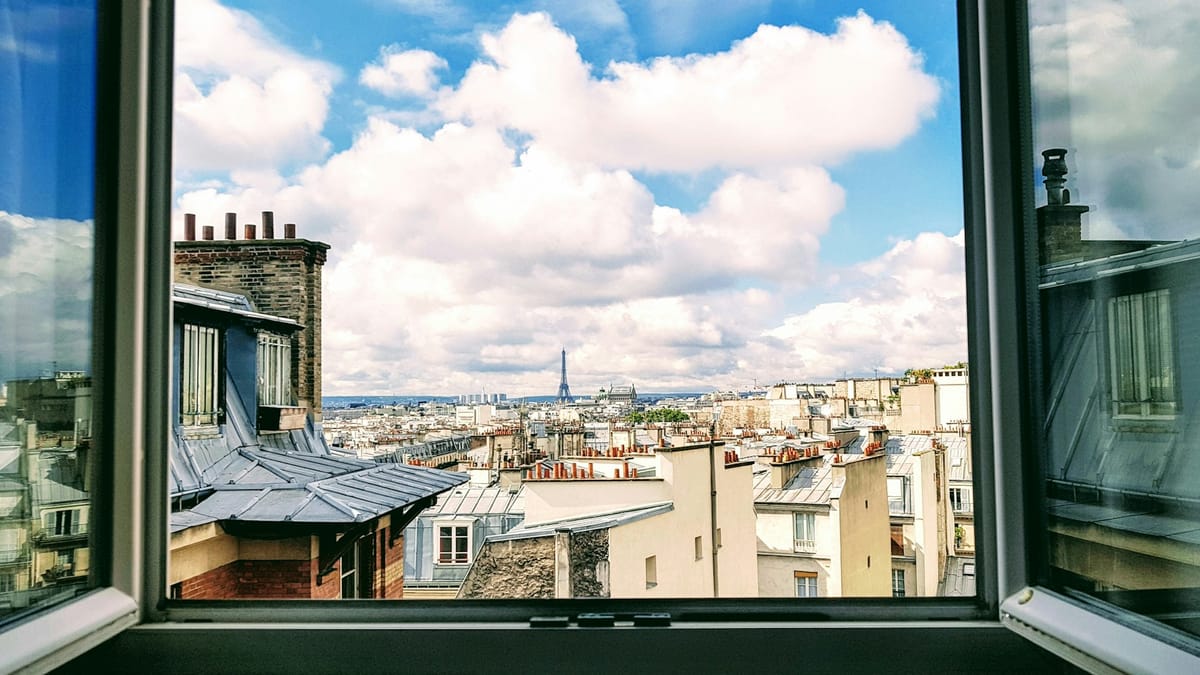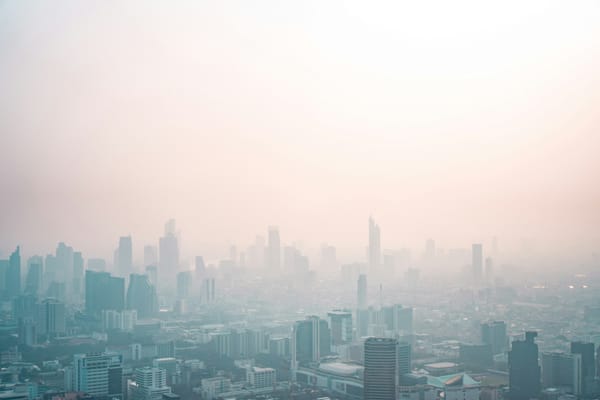How to improve the air quality in your home based on data
If you want to improve the air quality in your home based on data, this is what you can do.

In the first article of this series on air quality, we talked about how to measure and improve air quality in general. In this article, I write about how I strategically air my home and most practices that I do on a daily basis, based on the data that my air quality meter provides.
Note that circumstances are different in summer and in winter, because the environmental circumstances differ. In winter, the source of air pollution is mostly chimneys combined with high pressure weather conditions that hinder the air from mixing through or being blown away by the wind. That way, fine dust stays like a bell over the city. And that's when you see smog in the distance. In summer, in my city, there's more blue skies and more possibility for fresh air to come in. But people tend to make fires in the backyard, and that produces a lot of fine dust as well.
Regardless of the time of the year, traffic pollution is always prevalent.
CO2
The most common intervention is when I detect that CO2 levels are too high. Usually when they go above 1,500 ppm (parts per million) I can sense that I'm getting a little drowsy and that my mental performance declines. Sometimes I can get a little headache or just become tired.
Obviously this happens more quickly when the whole family is in the room and everyone is using up oxygen and no new fresh air comes in.
There are two common scenarios:
1) I see that the CO2 levels are too high. I open the windows and let fresh air in.
2) When the air quality outside is terrible, such as in the last few weeks when we had a weather condition here in Europe where a lot of Sahara sand would be mixed into the air and a high pressure weather condition led to that air not being carried away.
It created a bell that put the whole city in dust, so to speak. You could see that the horizon and buildings far away looked blurry, and fine dust levels were at the tenfold value of the recommended value by the WHO. The air quality index of IQ Air showed 120 to 140, which is unhealthy.
That condition lasted for almost a week, and during that week we didn't open the windows. We did not stay at home all day, but went to work and went to the mall for grocery shopping. I wore a mask outside to protect myself. That way we did not use up all oxygen and did not raise CO2 levels too high. We had enough oxygen in the evening and night.
My reasoning was that letting new air in wouldn't be a good idea. When I do that even when the air quality index is at 80 or 90, usually after a few seconds fine dust levels in my apartment are way too high. So in this case I didn't want to let that air in, but instead had my air purifiers on day and night.
When the air quality index is below 100, and CO2 levels are too high, I open the windows up to three times a day, and then I filter the air with my air purifier. I sometimes do that room by room and stay in another room, so I don't breathe in as much polluted air from outside. Obviously, when the index is below 40 and the air quality outside is very good, the windows stay open, and I'm just happy that there's fresh clean air coming in.
NO2
NO2 is a harmful gas that arises from combustion processes or traffic pollution.
Usually the source is outside, which means when I open the window I see that NO2 levels are going up, coming from chimneys or from traffic. Sometimes the source is inside and can come from certain ways of cooking or even if you have other forms of gas in the flat.
It's filtered out of the air pretty quickly compared to fine dust. When I put my air purifier on, it is filtered out fast.
Sometimes, I get NO2 levels that are way too high. When I can't find a source, it often correlates with higher humidity levels, because the electrochemical sensors that detect NO2 also react to water particles in the air. So when the humidity is high, the sensors sometimes detect the humidity and then show higher NO2 levels. Sometimes the sensors aren't calibrated correctly. They usually calibrate automatically and pretty well, but last time I came home from holidays, I detected that NO2 levels were thousandfold of the limit value, which was not plausible because there was no source. Nobody made a fire in my home when I was away. So it had to be that the sensor wasn't calibrated correctly, in which case I reset it and let it recalibrate. And that solved the problem.
VOC
VOC stands for volatile organic compounds. These are compounds that come from human waste. They come from plants that dissolve. But they can also be a sign of mold that builds up somewhere.
So usually a value over 1,000 ppb (parts per billion) is considered to be unsanitary, but not very harmful for health. Although long term exposure might cause health problems eventually. I try to stay under 1,000 ppb and works fine if I open the windows three times a day.
The VOC sensor can also detect water particles and show a higher value, but less often than the NO2 sensor. As an extreme example, that week when we had the windows closed because of the Sahara sand, VOC levels were elevated all the time, but they didn't surpass 1,500 ppb. They regulate down, and here's just not as much waste that you can produce for it to surpass those levels. Unless you have a compost toilet in your living room. Or mold.
Fine dust
Fine dust is measured in different particle sizes. They are PM1, PM2.5, and PM10, the latter being the biggest particle size.
Fine dust comes from traffic and chimney pollution or from Sahara sand, for example.
Fine dust is also the most common source of air pollution, and it's problematic because its fine particles go deeply into your lungs. From there they go into the bloodstream and from the bloodstream into the cells of your body and cause harm there because your body has no efficient way to get rid of them. That's why they potentially cause cancer or stroke or heart attack and even brain damage.
Fine dust is easy to handle. You just turn on your air purifier. But you should not underestimate how harmful fine dust is and how prevalent it is because it's in every city. When you open the window, there's fine dust. When you go outside without a mask, there's fine dust. In varying degrees, of course. And it's dependent on the weather condition.
It is there most of the time and it's harmful.
When I have my windows closed and my air purifier on, fine dust levels are usually at zero, which is amazing. But they go up pretty quickly once I open the window.
Most air quality indexes are based on some combination of fine dust and NO2 or other compounds. But fine dust being the base foundation of the calculation. So depending on how high fine dust pollution is outside, I decide to open or not open the windows and wait for times when fine dust levels are lower. They are never zero, but when they are lower, I can filter it out quickly.
A room that has levels of fine dust that are too high and unhealthy, which is 20 µg/m³ or more, takes my air purifier 10 to 15 minutes in turbo mode to clean out. So that's what you need to consider when opening the windows.
Relative humidity
A room should have between 40 and 60 percent humidity. Usually it will be on the higher end, but you want to make sure that it doesn't go above 70 percent, because then it's very easy for mold to occur and the more humid the air is, the more difficult it is to breathe.
The source of humidity is water, but if you leave a glass of water in an empty room, obviously the humidity won't just go up. When that water changes its aggregate state, it evaporates and the air becomes more humid.
When you take a very hot shower, and you don't have the windows open, but leave them closed, the relative humidity in that room goes up. If you leave the door of the bathroom open, that humidity can also obviously go into other rooms. If you hang your clothes to dry, after doing the laundry, the humidity goes up as well. If you cook something with boiling water, that raises humidity. All of these combined, because you live in a normal household and don't have the windows open all the time, you can see how easy it is for the relative humidity to go up and stay at the upper levels of that range.
One way to combat this is heating. What you don't want is to have low temperatures and high humidity, because these are perfect conditions for mold to grow. This is a common during winter time, especially in bedrooms, because some people prefer to sleep in cool rooms. In the summer, it's not so much of a problem.
Opening the windows is the best thing you can do to let humid air out and more dry air in.
But considering the other air pollution again, it's always a process of evaluating which compounds you want out, which compounds you want in, and how fast you can filter those that are unwanted out.
Other compounds
There are other compounds in the air that need some attention, but they play a minor role in daily life.
They are either not prevalent in everyday situations, such as ozone, or they are not as easy to remove, such as formaldehyde, which might emerge from furniture or paint.
If you detect high levels of that, you should find the source and get rid of it. But that's more of a one-time thing.
Chlorine can be found in detergents. Open the windows and consider using detergents that are less chemical.
Ammonia could be a sign to clean out the cat litter box or that you have mice or other rodent in the household.
Methane comes from flatulence, or your gas stove. I won't tell you to eat fewer beans and legumes, but maybe get a different stove.
Radon can be detected if there's radiation. If you live in a contaminated area, maybe you should consider moving. It might be detected in your basement, because lower layers of earth sometimes contain radon. Half-timber houses sometimes contain radon, because of the clay that was used for building. The same goes for clay plastered walls.
Carbon monoxide can be deadly. Sources can be a fireplace, heating installation, a chimney that is blocked (because of a bird's nest, for example), an indoor grill or gas stove.
I hope you found this helpful. If you have suggestions for improvement or have other tactics that you want me to include, contact me, and I'll be happy to include them here. Thank you for reading.



